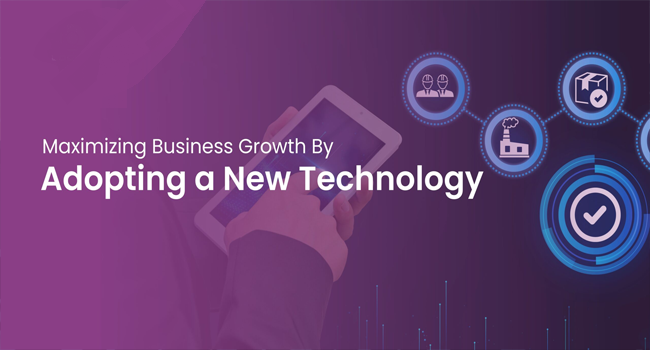Adopting Technology for Enhanced Business Growth

In the ever-evolving panorama of the international enterprise, staying ahead of the curve is vital for business growth. One of the important drivers of the boom in today’s virtual age is the strategic adoption of the era. Businesses that embrace and combine generation into their operations decorate their efficiency and role themselves for lengthy-term achievement. In this essay, we will explore the myriad approaches in which adopting generation can contribute to stronger enterprise increases.
Firstly, the era empowers groups to streamline operations and enhance typical performance. Automating recurring tasks, including facts access and customer support, permits personnel to recognize more complicated and price-delivered activities. This increases productivity and reduces the likelihood of errors, leading to higher-quality outputs. For instance, implementing Customer Relationship Management (CRM) software can centralize consumer records, enabling corporations to provide more customized and centred offerings.
Furthermore, mixing generations enhances communique and collaboration inside and outside the enterprise’s doors. Cloud-based collaborative equipment, video conferencing, and mission management software allow groups to paint seamlessly, regardless of geographical location. This is mainly applicable in a trendy, globalized commercial enterprise environment where teams may be spread across exceptional continents, improved communication consequences in quicker decision-making strategies, and the potential to respond extra hastily to market changes.
Another tremendous element of the adopting era is its impact on market reach and consumer engagement. The net and social media systems provide groups with remarkable opportunities to connect to an international audience. Digital marketing techniques, social media campaigns, and search engine optimization allow companies to target specific demographics and customize their outreach. E-commerce platforms allow businesses to reach customers beyond their physical locations, creating new markets and sales streams.
Moreover, this era allows information-pushed choice-making, imperative for sustained commercial enterprise growth. Advanced analytics equipment can manage massive amounts of data to extract valuable insights into purchaser behaviour, market developments, and operational performance. By leveraging these insights, corporations could make informed selections that align with market demands and capitalize on emerging possibilities. This records-driven approach enables organizations to refine and optimize their techniques for better outcomes constantly.
Adopting the era also plays a vital position in improving client enjoyment. From online chatbots that provide instantaneous customer support to cellular apps that provide seamless shopping reviews, technology allows agencies to meet the evolving expectancies of modern-day consumers. Personalized hints based on previous interactions and options create an experience of an individualized provider, fostering patron loyalty. Positive purchaser reports no longer most effectively cause repeat enterprise but also contribute to tremendous word-of-mouth advertising and marketing.
In addition to enhancing inner methods and consumer interactions, technology can also force innovation inside a commercial enterprise. Embracing emerging technologies, including artificial intelligence, digital reality, and blockchain, can open new product and carrier development opportunities. For example, incorporating AI algorithms into manufacturing strategies can optimize production efficiency, while digital reality can revolutionize how clients experience merchandise before creating a purchase choice. Businesses actively looking for and undertaking modern technologies position themselves as enterprise leaders, attracting customers and pinnacle talent.
While the benefits of adopting generation for commercial enterprise boom are glaring, coping with capacity challenges and risks is vital. The preliminary expenses of enforcing new technology alongside forneedloyee training can be vast hurdles. However, these investments are frequently outweighed by the aid of the lengthy-term profits in efficiency, productiveness, and competitiveness. Additionally, agencies must remain vigilant about cybersecurity to defend touchy information and preserve their customers’ agreement.
The continuous evolution of technology opens up new frontiers for agencies inclined to adapt and innovate. One of the areas in which the era is making large strides is within the realm of synthetic intelligence (AI). Machine mastering algorithms, a subset of AI, can analyze giant datasets to pick out styles and make predictions, allowing businesses to make more informed decisions. For instance, AI-powered predictive analytics can assist agencies in counting on market tendencies, optimizing stock control, or even forecasting customer alternatives.
Moreover, integrating Internet of Things (IoT) gadgets further complements agencies’ talents. IoT devices, ranging from clever sensors to the wearable era, generate a wealth of real-time statistics. These statistics may be leveraged to screen and optimize numerous aspects of enterprise operations, from delivery chain control to equipment renovation. For instance, in production, IoT-enabled sensors on equipment can provide real-time performance information, bearing in mind predictive preservation and minimizing downtime.
Blockchain technology is another progressive pressure that can convert industries. Blockchain’s decentralized and secure nature makes it ideal for packages, including delivery chain transparency, virtual identification verification, and stable monetary transactions. By adopting blockchain, businesses can build customer trust via obvious and tamper-evidence information. This effectively mitigates the threat of fraud and enhances the business’s credibility in the eyes of stakeholders.
Furthermore, the growing significance of sustainability in commercial enterprise practices can be addressed via technology adoption. Businesses are increasingly spotting the need to perform in environmentally friendly approaches, which can play a pivotal role in attaining sustainable practices. Cloud computing, as an example, permits groups to lessen their bodily infrastructure, mainly by decreasing electricity consumption. Additionally, data analytics can identify regions where useful resource usage can be optimized, contributing to each environmental conservation and fee financial savings.
As agencies navigate the virtual landscape, digital transformation will become paramount. Digital transformation entails a holistic reimagining of business tactics, customer interactions, and even enterprise fashions via the integration of virtual technology. This overarching approach guarantees that generation isn’t just a device but a driving force that permeates everything in the commercial enterprise. Successful virtual transformation calls for a cultural shift within the company, fostering adaptability, non-stop learning, and a willingness to embrace trade.
In the context of more desirable business growth, virtual transformation enables companies to stay agile and aware of marketplace dynamics. It involves a strategic alignment of technology initiatives with general business goals. For example, a retail business’s present process of digital transformation may focus on developing an unbroken omnichannel revel for customers, integrating online and offline channels to offer a cohesive shopping journey. This method meets client expectations and positions the commercial enterprise for the boom in an increasingly more virtual retail landscape.
However, it is essential to notice that adopting generation and digital transformation isn’t always a one-length-suits-all answer. Therefore, businesses must assess their precise needs, industry dynamics, and organizational subculture to tailor era adoption strategies. This personalized technique ensures that the era aligns with the specific goals and challenges of the enterprise, maximizing its impact on boom and sustainability.
In the end, adopting technology is now not an alternative but a need for corporations aiming for stronger increase and sustainability. From enhancing operational performance and fostering innovation to increasing marketplace attain and improving customer experiences, generation performs a multifaceted position using commercial enterprise fulfilment. Businesses that proactively include and integrate technology into their techniques position themselves to thrive in the dynamic and competitive landscape of the modern business world. As we look to the future, the continued evolution of the era will gift even more possibilities for organizations to innovate and grow, making it imperative for agencies to live at the vanguard of technological improvements.

